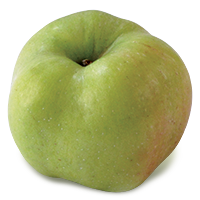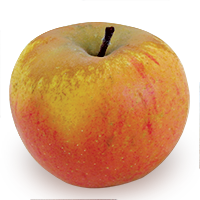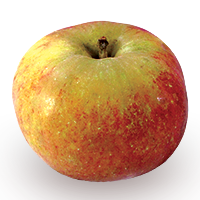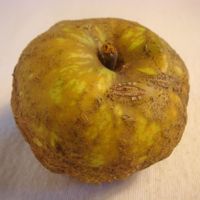
There is plenty of good picking at New England orchards like Red Apple Farm in Phillipston, Massachusetts (Russell Steven Powell photo)
EUROPEAN COUNTRIES have produced only a few new apples in recent years. But several venerable heirlooms still grown in New England originated in France, Germany, and The Netherlands. Many of the apples are so old and the records so incomplete that their country of origin cannot be completely certain.
AMONG THE BEST New England apples generally credited to France are three of the oldest named varieties: Ananas Reinette, Calville Blanc d’Hiver, and Lady.
Ananas Reinette (ô-nô-ńas rĭ-ńĕt) is a small, late-season apple, round or slightly oblate, with rich yellow color over green skin, and prominent green or brown lenticels (the dots on an apple’s skin through which it “breathes”). Ananas Reinette has crisp, juicy, white flesh, and a balanced, sweet-tart flavor with hints of pineapple (“ananas” is French for pineapple). Its distinctive flavor intensifies in storage.
Although it was first cited in 1821 in Germany, it may have originated in The Netherlands or France in the 1500s. It received scant mention in American reference works before 1950.
Calville Blanc d’Hiver (kal-vəl bläŋk dē-ver), or simply White Calville, is another late-season apple with yellow-green skin. It is medium to large, with a distinctive ribbed shape and an occasional pink blush. Its aromatic, cream-colored flesh is spicy, more tart than sweet, and its flavor intensifies in storage. It is high in Vitamin C. One of Thomas Jefferson’s favorite apples, it is mostly used in cooking and in cider, and it stores well.
Its age and origin are unknown, but it was first recorded in 1598 France (some accounts attribute it to Germany).
Another late season apple, Lady, also known as Api or Christmas Apple, is small in size but intense in flavor. Its red-and-green color varies according to the amount of sunlight it gets; the green areas can lighten to yellow. Its bright white flesh is crisp, juicy, and tart, with hints of citrus.
Lady is best in salads, eaten fresh, and pickled, sweet or sour, and sometimes served with a hot sauce. Due to its small size, festive coloring, and ability to withstand a freeze, Lady is often featured in Christmas wreaths.
Lady has been cultivated in France at least since the reign of Louis XIII in the 1600s. But it may be even older, dating back to ancient Rome. It was one of the first European apples to be brought to America.
Calville Blanc d’Hiver and Lady apples appear to be the subjects of Claude Monet’s oil painting, “Still Life with Apples and Grapes” from 1880.
Orleans Reinette (ôr- lēnz rĭ-ńĕt), or Winter Ribston, is also a late-season French apple. Medium to large, round and oblate, it is strikingly beautiful, with random patches of russet and bronze blush on a rosy red skin. Its cream-colored flesh is crisp and juicy, and its complex flavor is more sweet than tart, with hints of nuts and orange. The late food writer Edward Bunyan called Orleans Reinette “the best tasting apple in the world.”
First cited in 1776, it is one of several varieties with “reinette” in its name, a French term for russeting. Most reinette apples are very old, dating back to at least the 1700s.
GERMANY’S CONTRIBUTIONS to New England are similarly old, with one exception: Corail.
Corail is a late-season apple with a conical shape and streaks of bright red over a yellow-orange skin. Its white flesh is crisp and juicy, and it resists browning when sliced. Corail’s flavor is more tart than sweet, with hints of pineapple or citrus.
Corail was developed in 2000 from Golden Delicious, Cox’s Orange Pippin, and Duchess of Oldenburg parents. It is now marketed under the trademarked name Piñata, and Stemilt Growers of Wenatchee, Washington, holds exclusive rights to grow, market, and sell it in the United States. Some New England growers had already purchased Corail, though, and they are allowed to continue to grow and sell the apple using that name. It is also known as Pinova or Sonata.
Gravenstein is an early season apple, medium-sized, slightly blunt and conical, with blurry red streaks on a thin green skin. Its cream-colored flesh is crisp and juicy, with flavor that is more tart than sweet. It is especially good in pies, sauce, and cider, and it stores better than most early varieties.
Dating back to at least the 1600s, Gravenstein was popular in New England from the late 1800s until the 1930s. It migrated across Europe, probably originating in Germany, although it may have been discovered in Italy. It first appeared in Denmark about 1669 and England in 1819.
Gravenstein, German for the southern Denmark town of Gråsten, is strongly identified with Denmark — it was declared Denmark’s national apple in 2005. It may be one of several European apples imported to the United States by the Massachusetts Horticultural Society in the 1800s.
Red Gravenstein is an early season sport variety (resulting from a mutating branch) of Gravenstein. Medium-sized, slightly blunt and conical, it is redder and sweeter than its parent. Its cream-colored flesh is crisp and juicy, with a nicely balanced, sweet-tart flavor.
Red Gravenstein was first cited in 1873.
Holstein is a medium, round, mid-season apple, yellow in color with red streaks. Its cream-colored flesh is coarse-textured, moderately crisp, and juicy. Its flavor is balanced between sweet and tart, and it stores well.
Holstein was discovered by a teacher named Vahldik in Eutin, Holstein, in 1918. Its parentage includes Cox’s Orange Pippin.
Zabergäu Reinette (źab-ər-gau̇ rĭ-ńĕt) is a medium to large, mid-season apple, with light, copper-colored russeting over yellow skin. Its crisp, cream-colored flesh is moderately juicy, and its spicy, nutty flavor, more sweet than tart, intensifies in storage. It is good for fresh eating and in cooking, and it keeps well.
Zabergäu Reinette was first grown in 1885 in Württemberg, on the Zaber River in southwestern Germany, but was not widely distributed until 1926.
THE NETHERLANDS has produced three apples of note that can be found in New England orchards.
Elstar is a medium to large, late-season apple, yellow with red streaking. Its cream-colored flesh is crisp, and its flavor, more tart than sweet, has been compared to Jonagold. It is a good fresh eating and cooking apple. Its flavor mellows some in storage.
A cross between Golden Delicious and Ingrid Marie, a variety from Denmark dating back to 1910, Elstar was first grown in the Netherlands in the 1950s and released commercially in 1972. While it prefers a cooler climate, it is not yet widely grown in New England.
Karmijn de Sonnaville is a medium-sized, mid-season apple with complex coloring, with shades of red, orange, yellow, and green. Its crisp, juicy flesh has a rich, spicy flavor balanced between tart and sweet. It is outstanding for fresh eating and excellent in cider.
It was raised by Piet de Sonnaville in 1949 on his family orchard in central Netherlands from Cox’s Orange Pippin and Jonathan or Belle de Boskoop parents, and introduced in 1971. Like Jonagold, Karmijn de Sonnaville’s exceptional flavor and beauty have not resulted in commercial success in the United States, as it is challenging to grow and difficult to name.
Belle de Boskoop is a medium to large, late-season apple with a round, boxy shape. It has russeting around its stem and in a netting pattern over much of its distinctive orange-red skin. Its crisp, light-green flesh is aromatic, moderately juicy, and more tart than sweet, with hints of lemon. Its flavor becomes sweeter in storage, and it keeps well.
Belle de Boskoop was discovered by K. J. W. Ottolander in 1856 in his nursery in Boskoop, near Gouda. It was introduced in North America in Canada around 1880.
* * *
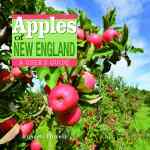 RUSSELL STEVEN POWELL will read from and sign his new book, Apples of New England (Countryman Press) at two central Massachusetts locations this weekend, including the Tower Hill Botanic Garden, which maintains one of the largest preservation orchards in New England, with 119 pre-1900 varieties.
RUSSELL STEVEN POWELL will read from and sign his new book, Apples of New England (Countryman Press) at two central Massachusetts locations this weekend, including the Tower Hill Botanic Garden, which maintains one of the largest preservation orchards in New England, with 119 pre-1900 varieties.
A number of extremely rare apples from Tower Hill are described in Apples of New England and photographed by Bar Lois Weeks.
Saturday, October 4, 1 p.m.
Wales Rd., Monson, Massachusetts
*
Sunday, October 5, 12:30 p.m.
11 French Dr., Boylston, Massachusetts

